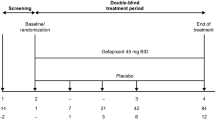Abstract
Purpose. The present study was conducted to evaluate theeffects of formulation pH and dose on nasal absorption of scopolaminehydrobromide, the single most effective drug available for the prevention ofnausea and vomiting induced by motion sickness.
Methods. Human subjects received scopolamine nasally at adose of 0.2 mg/0.05 mL or 0.4 mg/0.10 mL, blood samples were collected atdifferent time points, and plasma scopolamine concentrations were determinedby LC-MS/MS.
Results. Following administration of a 0.2 mg dose, theaverage Cmax values were found to be 262 ± 118, 419± 161, and 488 ± 331 pg/mL for pH 4.0, 7.0, and 9.0formulations, respectively. At the 0.4 mg dose the average Cmaxvalues were found to be 503 ± 199, 933 ± 449, and 1,308± 473 pg/mL for pH 4.0, 7.0, and 9.0 formulations, respectively. At a0.2 mg dose, the AUC values were found to be 23,208 ± 6,824, 29,145± 9,225, and 25,721 ± 5,294 pg.min/mL for formulation pH 4.0,7.0, and 9.0, respectively. At a 0.4 mg dose, the average AUC value wasfound to be high for pH 9.0 formulation (70,740 ± 29,381 pg.min/mL)as compared to those of pH 4.0 (59,573 ± 13,700 pg.min/mL) and pH 7.0(55,298 ± 17,305 pg.min/mL) formulations. Both the Cmaxand AUC values were almost doubled with doubling the dose. On the otherhand, the average Tmax values decreased linearly with a decreasein formulation pH at both doses. For example, at a 0.4 mg dose, the averageTmax values were 26.7 ± 5.8, 15.0 ± 10.0, and 8.8± 2.5 minutes at formulation pH 4.0, 7.0, and 9.0, respectively.
Conclusions. Nasal absorption of scopolamine hydrobromidein human subjects increased substantially with increases in formulation pHand dose.
Similar content being viewed by others
REFERENCES
American Hospital Formulatory Service (AHFS) 95 Drug Information. American Society of Health-System Pharmacists, Inc., Bethesda, MD, 1995, pp. 801–804.
A. Garybiel. Prevention and treatment of space sickness in shuttleorbiter missions. Aviat. Space Environ. Med. 50:171–176 (1979).
C. D. Wood and A. Garybiel. Evaluation of 16 anti-motion sickness drugs under controlled laboratory conditions. Aerospace Med. 39:131–134 (1968).
H. I. Chinn, R. W. Hyde, and J. R. Milch. Prevention and treatment of motion sickness by intranasal medication. Proc. Soc. Exp. Biol. Med. 90:666–669 (1955).
L. Putcha, N. M. Cintron, J. Tsui, J. M. Vanderploeg, and W. G. Kramer. Pharmacokinetics and oral bioavailability of scopolamine in normal subjects. Pharm. Res. 6:481–485 (1989).
N. M. Cintron and Y. A. Chen. A sensitive radioreceptor assay for determining scopolamine concentrations in plasma. J. Pharm. Sci. 76:328–332 (1987).
J. Shaw and J. Urquhart. Programmed systemic delivery by the transdermal route. Trends Pharmacol. Sci. 2:208–211 (1980).
Y. W. Chien and S. F. Chang. Intranasal drug delivery for systematic medications. In S. D. Bruck (ed), Critical Reviews in Therapeutic Drug Career Systems, CRC Press Inc., Boca Raton FL, 1987, pp. 67–194.
J. Tonndorf, H. I. Chinn, and J. E. Lett. Absorption from nasal mucous membrane: Systemic effect of hyoscine following intranasal administration. Ann. Otol., Rhinol., Laryngol. 62:630–641 (1953).
R. W. Hyde, J. Tonndorf, and H. E. Chinn. Absorption from the nasal mucous membrane. Ann. Otol., Rhinol., Laryngol. 62:957–968 (1953).
M. Gibaldi and D. Perrier. Pharmacokinetics, 2nd ed., Marcel Dekker, New York (1982).
S. Kagatani, N. Inaba, M. Fukui, and T. Sonobe. Nasal absorption kinetic behavior azetirelin and its enhancement by acylcarnitines in rats. Pharm. Res. 15:77–81 (1998).
H. Nomura, S. Akamisaka, and K. Maruyama. Effects of dosing solution on the nasal absorption of non-glycosylated recombinant human granulocyte colony-stimulating factor in rats. Biol. Pharm. Bull. 19:1490–1493 (1996).
N. Shimoda, Y. Maitani, Y. Machida, and T. Nagai. Effects of dose, pH, and osmolarity on intranasal absorption of recombinant human erythropoetin in rats. Biol. Pharm. Bull. 18:734–739 (1995).
A. A. Hussain, R. Bawarshi-Nasar, and C. H. Huang. Physicochemical considerations in intranasal drug administrations. In Y. W. Chien (ed), Transnasal Systemic Medications, Elsevier, Amsterdam, 1985, pp. 121–137.
T. Ohwaki, H. Ando, S. Watanabe, and Y. Miyake. Effects of dose, pH, and osmolarity on nasal absorption of secretin. J. Pharm. Sci. 74:550–552 (1984).
S. Hirai, T. Ikenaga, and T. Maatsuzawa. Nasal absorption of insulin in dogs. Diabates. 27:296–299 (1978).
Author information
Authors and Affiliations
Rights and permissions
About this article
Cite this article
Ahmed, S., Sileno, A.P., deMeireles, J.C. et al. Effects of pH and Dose on Nasal Absorption of Scopolamine Hydrobromide in Human Subjects. Pharm Res 17, 974–977 (2000). https://doi.org/10.1023/A:1007551927177
Issue Date:
DOI: https://doi.org/10.1023/A:1007551927177




